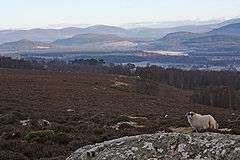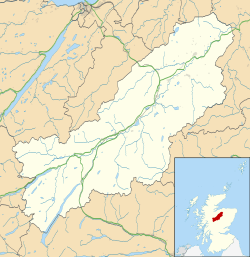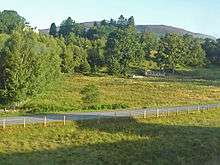Dunachton
Dunachton (Scottish Gaelic: Dùn Neachdain) is an estate on the north-west shore of Loch Insh in Badenoch and Strathspey, in the Highlands of Scotland. It occupies land immediately to the north of the A9 road and General Wade's Military Road.
Dunachton
| |
|---|---|
 Dunachton Moor | |
 Dunachton Location within the Badenoch and Strathspey area | |
| OS grid reference | NH820047 |
| • Edinburgh | 86 mi (138 km) SSE |
| • London | 417 mi (671 km) SSE |
| Council area | |
| Lieutenancy area |
|
| Country | Scotland |
| Sovereign state | United Kingdom |
| Post town | KINGUSSIE |
| Postcode district | PH21 |
| Dialling code | 01540 |
| Police | Scotland |
| Fire | Scottish |
| Ambulance | Scottish |
| UK Parliament | |
| Scottish Parliament | |
Recent research has suggested Dunachton as a potential location for the Battle of Dun Nechtain in 685 in which the Picts permanently secured independence from the Northumbrians.
History


The area around Dunachton shows evidence of human occupation in prehistory, with flintwork and whetstones being found in the vicinity.[1]
The name Dunachton derives from Dun Neachdain the fort of Nechtan. Nechtan's identity is unknown, but it is likely he was one of several of the early Pictish Kings that went by that name.[2]
Dunachton had some importance in the Early Medieval period. It is the site of an early class I Pictish stone which was discovered in 1870, having been recycled as a lintel stone in a farmstead building. Dunachton is first documented as 'Dwnachtan' in 1381,[3] in reference to the 'capelle de Nachtan', the Chapel of Nechtan,[4] which was dedicated to St Drostan.
Recent research has pointed to the possibility that Dunachton may have been the correct site of the Battle of Dun Nechtain in 685, when Bridei mac Bille, king of the Pictish kingdom of Fortriu defeated Ecgfrith of Northumbria, securing Pictish independence from Northumbria. The battle site was previously thought to be somewhere in the vicinity of Dunnichen in Angus, but reappraisal of the scant documentary evidence along with the reappraisal of Fortriu as being north of the Grampian Mountains has led to the suggestion that Dunachton is the true location.[5]
Dunachton Lodge was built on the remains of Dunachton Castle.[6] The landowners were originally the MacNivens, who as a sept of the MacNaughtons, claim descent from Nechtan. The barony subsequently came into possession of the Clan Mackintosh in the early 16th century through the marriage of Isabel MacNiven, the heiress of the Barony of Dunachton to William Mackintosh, cousin of the chief of the clan Mackintosh, and later chief of Clan Mackintosh and the wider Chattan Confederation.[7]
A centuries-old feud between the Mackintoshes and Clan MacDonald of Keppoch came to a head in 1688 at the Battle of Maol Ruadh. Dunachton Castle was destroyed the following year by Coll MacDonald under the auspices of the Jacobite cause, provoking a public rebuke from Dundee.[8] It was never rebuilt.[9]
Dunachton was bought in the 1950s by Andrew Forbes-Leith, who later inherited the baronetcy of Fyvie. In the 1970s he turned 600 acres (2.4 km2) of Dunachton into the Highland Wildlife Park.[10]
Notes
- Wordsworth and Harden
- Seton p200
- Registrum episcopatus Moraviensis p93; p188
- Registrum episcopatus Moraviensis p93; p184
- Woolf
- Canmore Record: Dunachton Lodge
- Shaw p77; Seton p201; Adam and Innes p163
- Roberts p180
- Shaw p77
- Andrew Forbes Leith obituary
References
- Daily Telegraph (22 November 2000), "Sir Andrew Forbes-Leith, Bt", The Daily Telegraph, London, retrieved 17 September 2009
- Registrum episcopatus Moraviensis, e pluribus codicibus consarcinatum, Edinburgh: Bannatyne Club, 1837
- Records of the Parliaments of Scotland (1690), Act in favour of {Lauchlan MacIntosh}, laird of MacIntosh anent his damages, retrieved 20 September 2009
- Adam, Frank; Innes, Thomas (1934), The Clans, Septs and Regiments of the Scottish Highlands, Kessinger, ISBN 978-1-4179-8076-5
- Roberts, John Leonard (2000), Clan, King and Covenant: history of the Highland Clans from the Civil War to the Glencoe Massacre, Edinburgh: Edinburgh University Press, ISBN 0-7486-1393-5
- Royal Commission on the Ancient and Historical Monuments of Scotland, "Dunachton Pictish Symbol Stone", Canmore database, retrieved 17 September 2009
- Royal Commission on the Ancient and Historical Monuments of Scotland, "Dunachton Lodge", Canmore database, retrieved 17 September 2009
- Seton, Gordon (1948), Highways and Byways in the Central Highlands, London: Macmillan, ISBN 978-1-4067-6745-2
- Shaw, Lachlan (1827), The History of the Province of Moray (New ed.), Elgin: J Grant
- Stewart, William Grant (1860), Lectures on the Mountains; or the Highlands and Highlanders of Strathspey and Badenoch as they were and as they are, London: Saunders Otley and co.
- Woolf, Alex (2006), "Dun Nechtain, Fortriu and the Geography of the Picts", The Scottish Historical Review, 85 (2): 182–201, doi:10.1353/shr.2007.0029.
- Wordsworth, J; Harden, G (1986), "Dunachton fieldwalking collection" (PDF), Discovery and Excavation in Scotland: 16